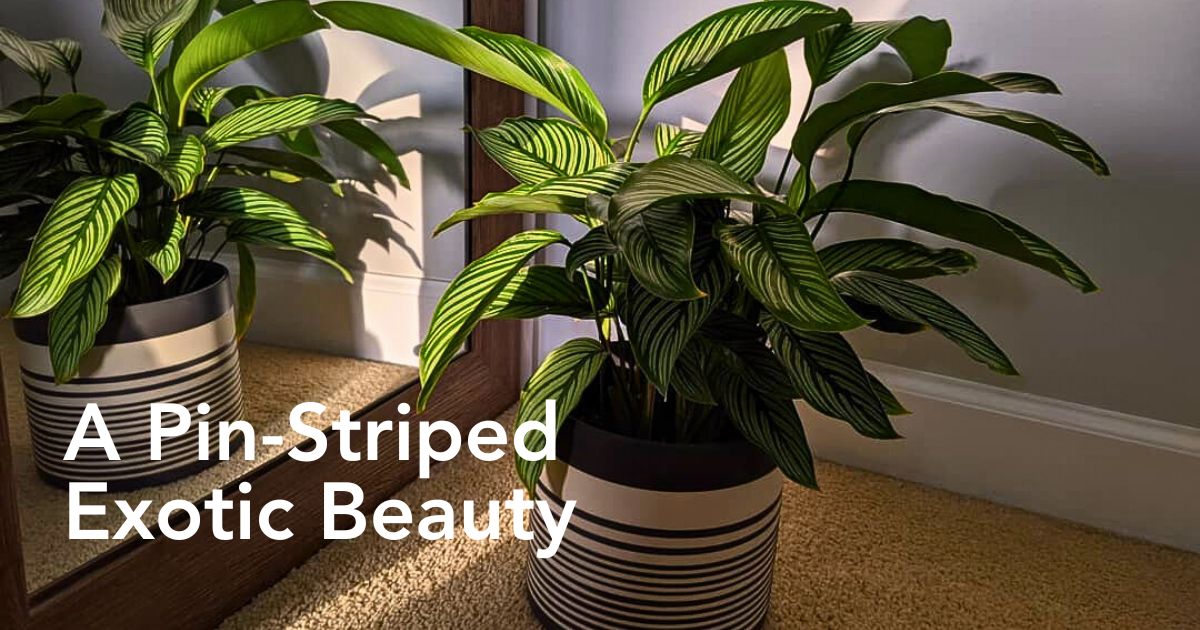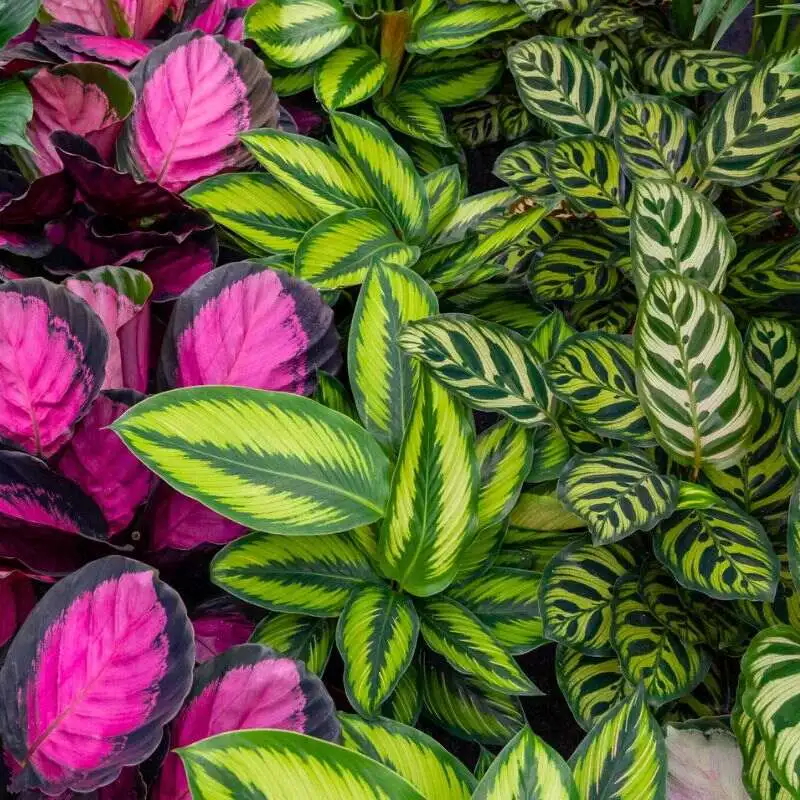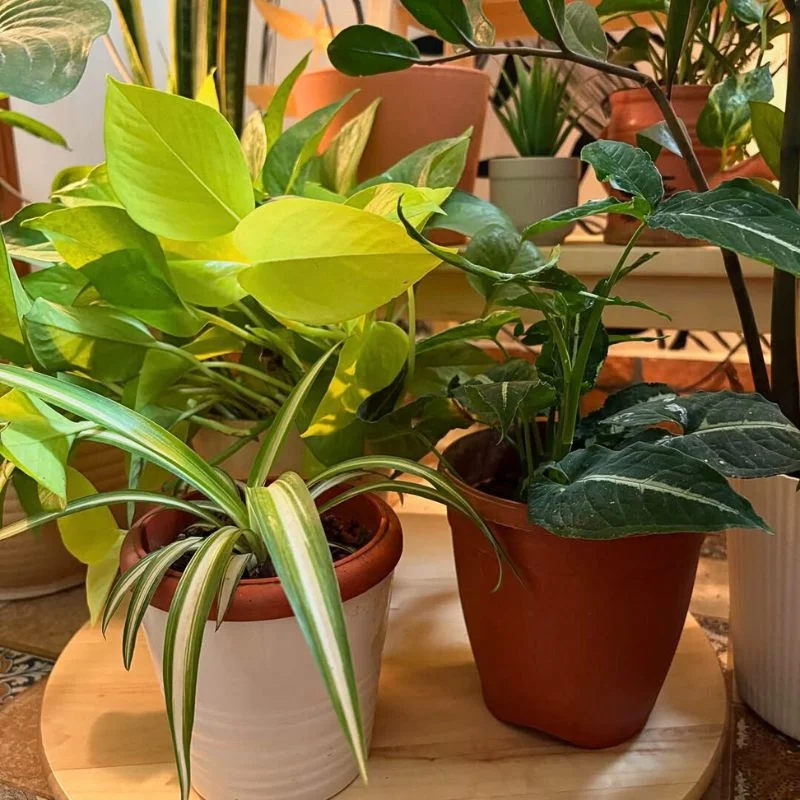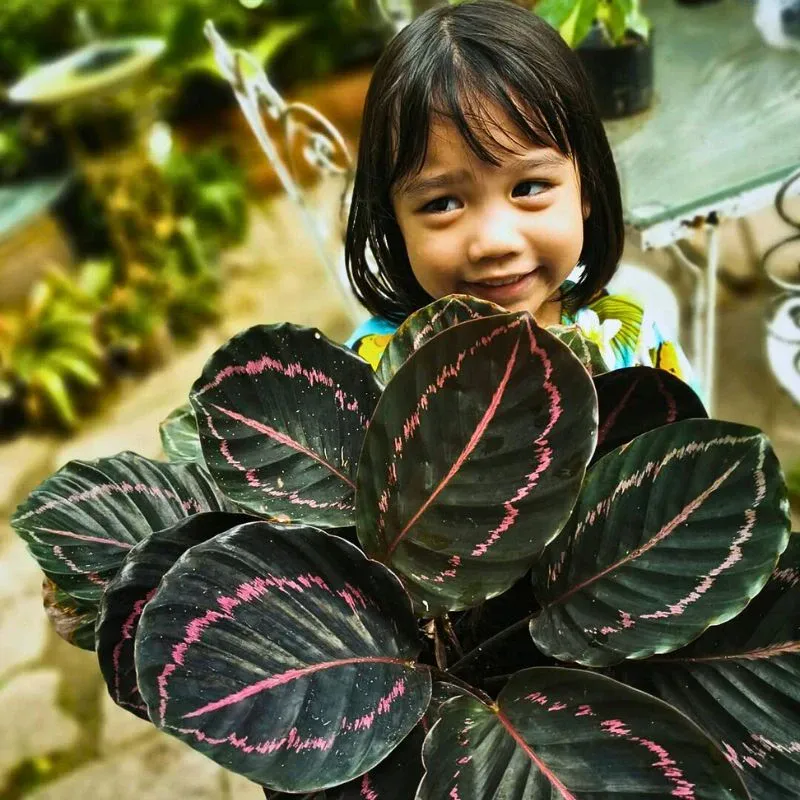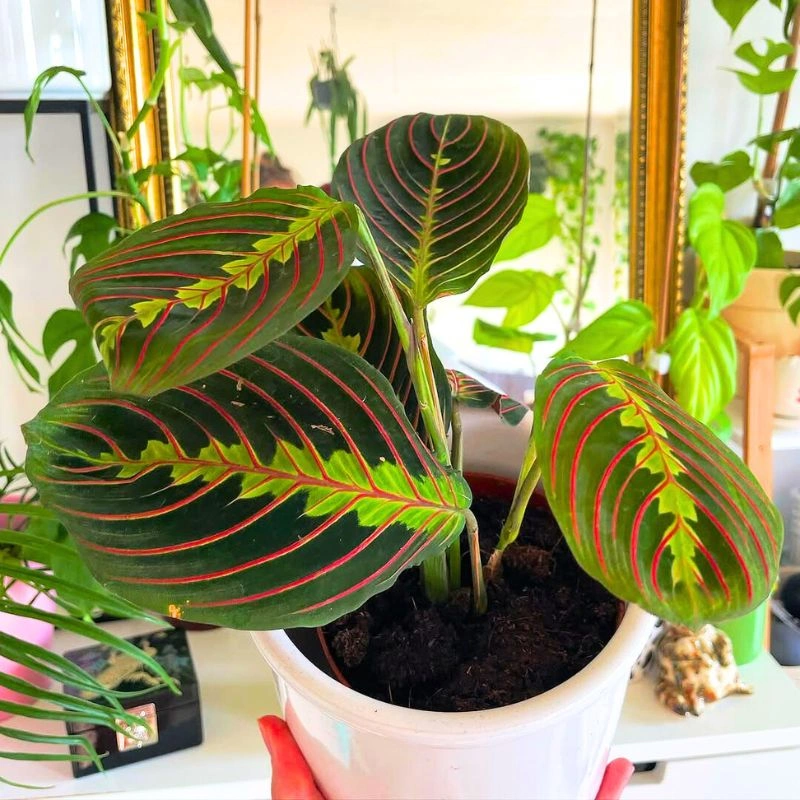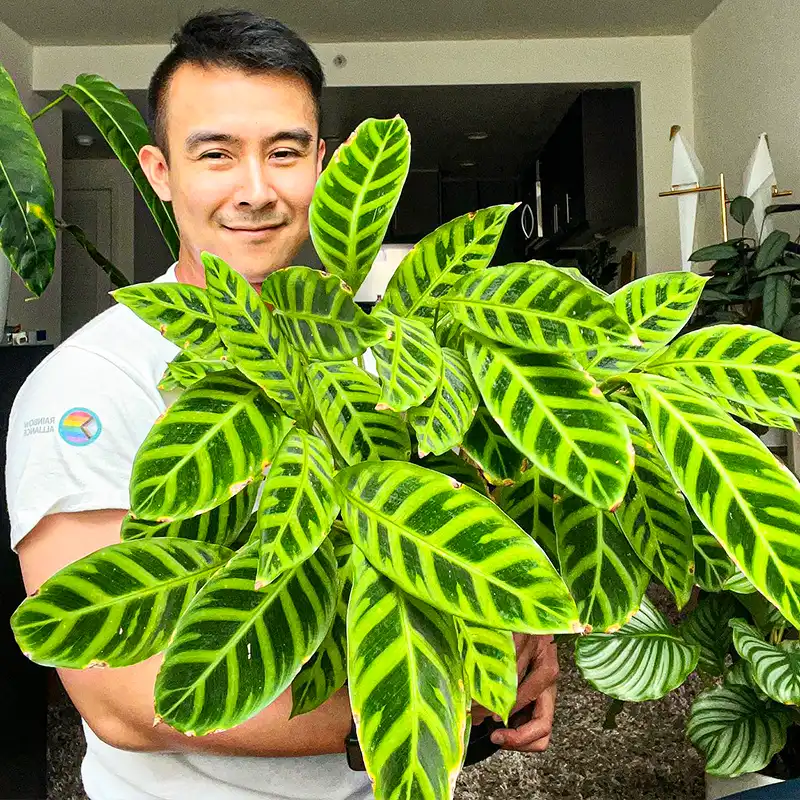With a name as enigmatic as it is recherché, the Calathea vittata (syn. Goeppertia elliptica) is quite a houseplant work of art; the kind that easily turns any mundane space into a lavish habitat of tropical verdure. In Latin, this exotic houseplant’s specific epithet means wearing or carrying a ritual vitta—ribbon or band, often used in religious or decorative contexts.
This name speaks of the plant’s unique lance-shaped leaves with a combination of dark green and light green stripes or bands that run along the length of the leaves, and its aristocratic bearing and temperamental nature, which always demand attention, not simply as a decorative element, but also as a floral beauty that offers glorious displays of patterned perfection in response to ideal care.
Meet the Striped Beauty, Calathea Vittata
Scientifically known as Goeppertia elliptica, the Calathea vittata plant belongs to the Marantaceae family, affectionately called the prayer plant family, whose members are renowned for their distinctive nocturnal leaf movements. This striped beauty hails from the undergrowth of tropical rainforests of Central and South America, specifically in Brazil, Colombia, and Peru, where it thrives in the humid and dark conditions found under the forest canopy. These conditions are enhanced by the dappled light filtering through the awning above.
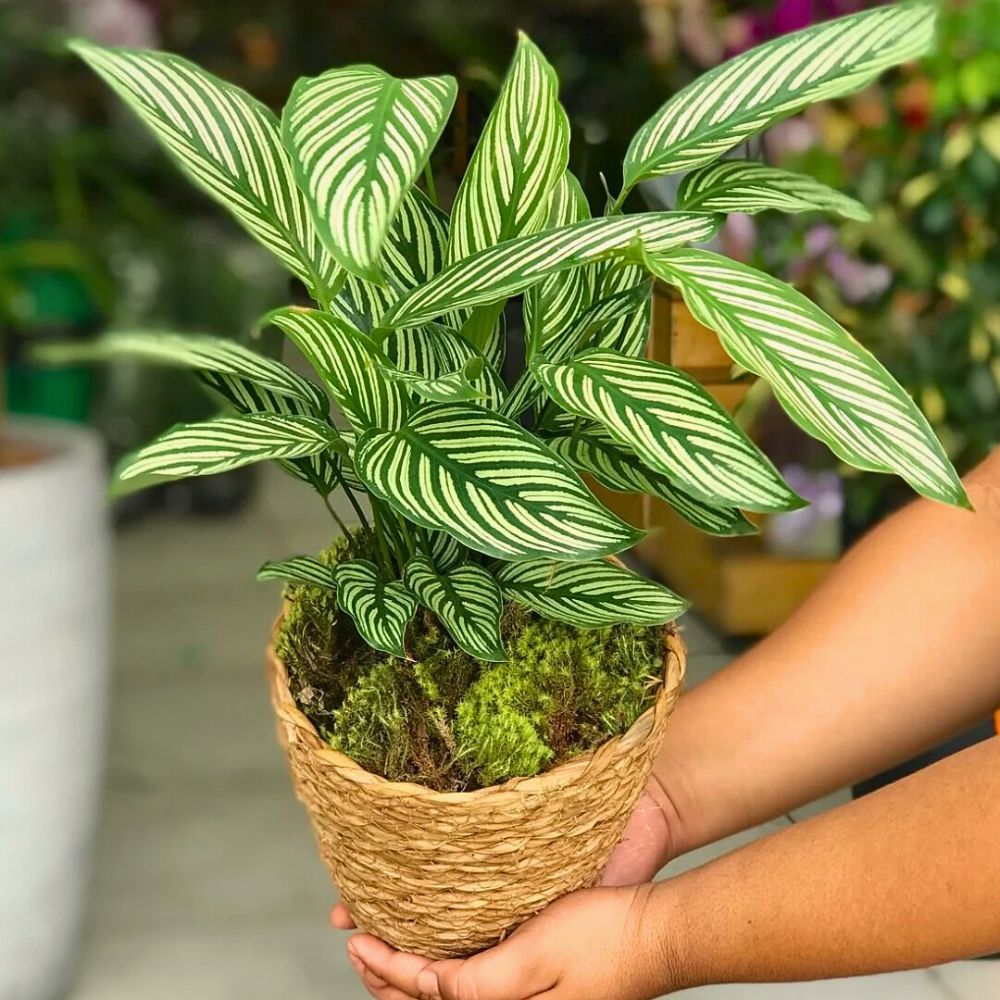
The signature feature of the Calathea vittata plant is its exquisite foliage; its elliptical leaves, which are adorned with striking white pinstripes against a backdrop of rich green, and which create a visual delight quite unlike any produced by many other houseplant varieties. These leaves easily draw the eye.
A unique distinction of the Calathea vittata stems from its nyctinastic movement—the mesmerizing daily ritual in which leaves unfurl horizontally during daylight hours to maximize light absorption and gracefully fold upward at nightfall, resembling hands in prayer. This extraordinary behavior evolved to conserve moisture and protect the plant in its native habitat, and continues even in domestic settings.
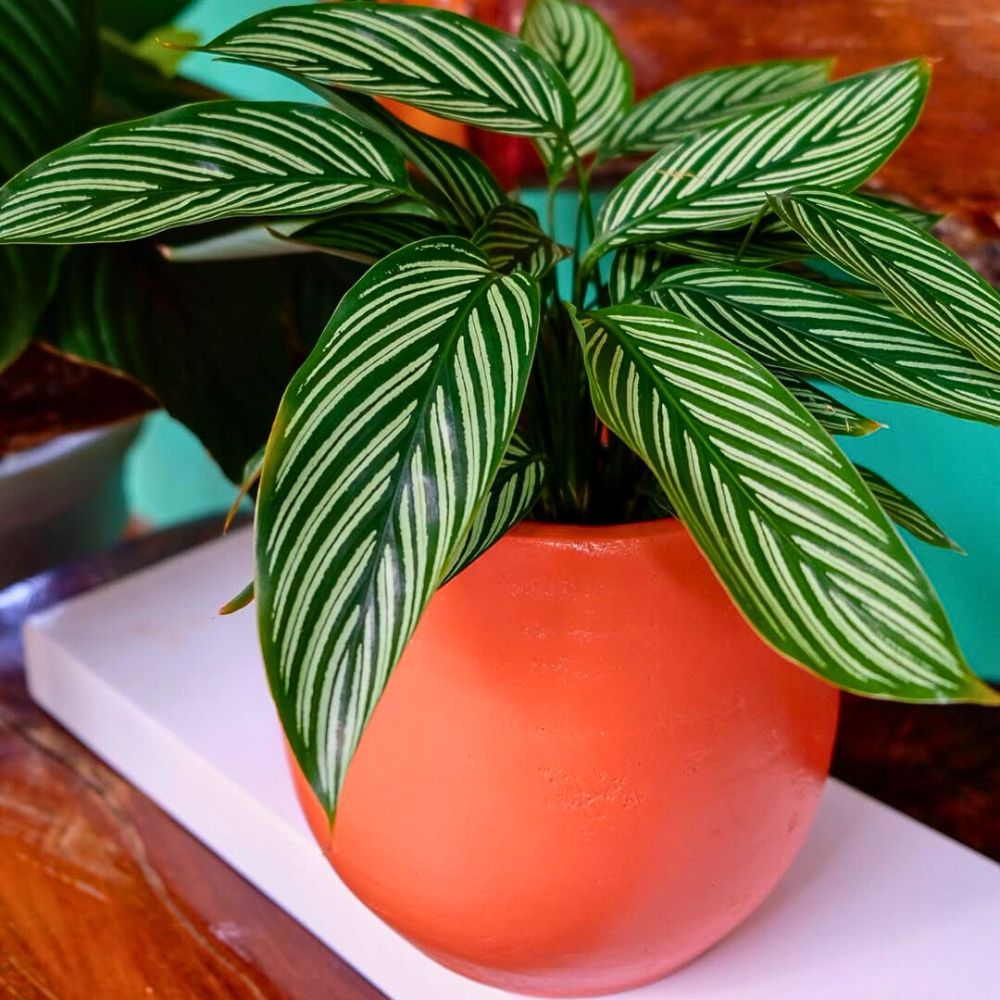
The houseplant grows to a moderate height, creating a naturally rounded, bushy form that fills spaces with tropical stylishness. In contrast to some ostentatious flowering plants, the Calathea vittata does not rely on blooms for its appeal; its foliage provides year-round visual interest, eliminating the feast-or-famine cycle of other flowering specimens.
Perfect Environments and Conditions for Calathea Vittata Cultivation
Recreating the rainforest conditions necessary for this houseplant’s cultivation is, by and large, what successful Calathea vittata cultivation hinges upon. A microenvironment that echoes the plant's natural habitat: humid, filtered-light conditions of tropical rainforest understories are perhaps all that is required. These specialized growing parameters, when faithfully reproduced, could turn your ordinary homes into spaces where these magnificent plants can achieve their full aesthetic potential.
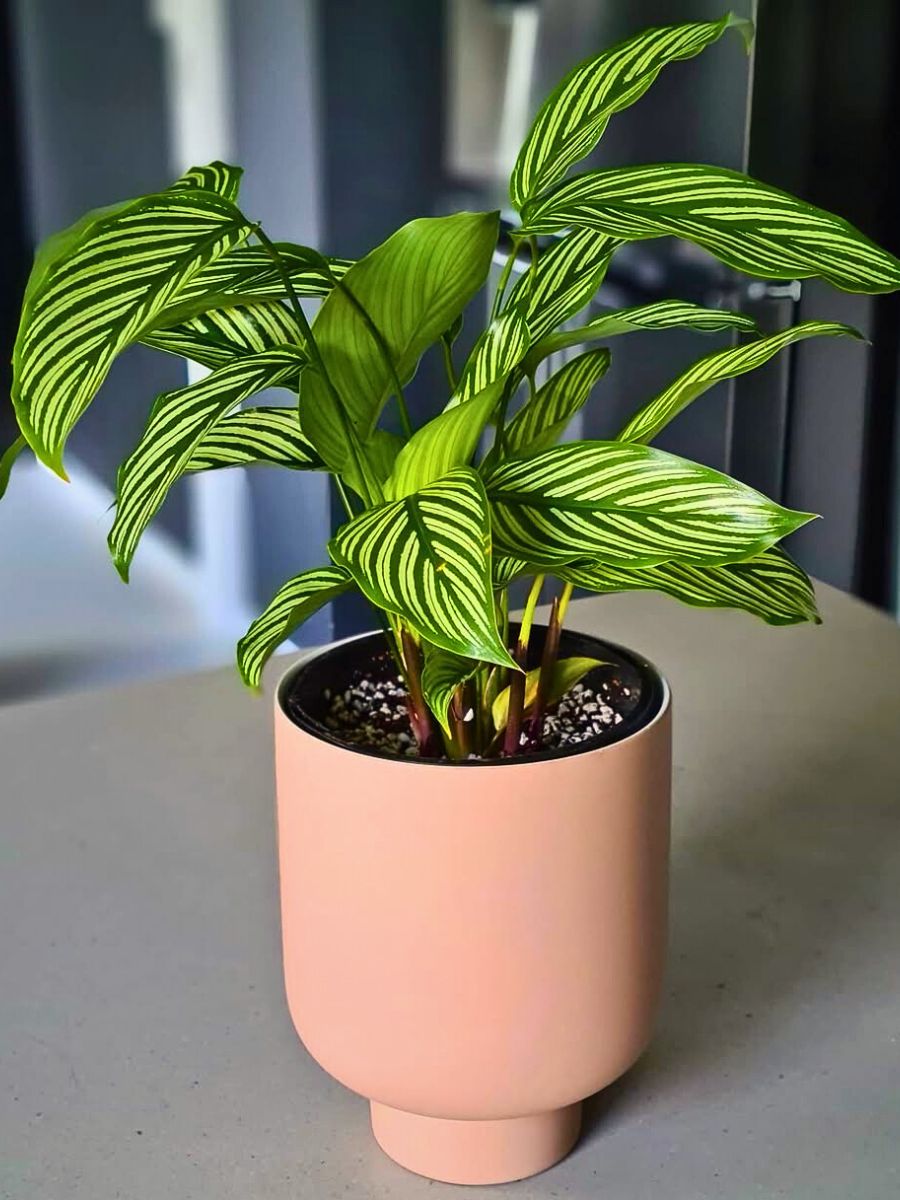
The foundation of effective Calathea vittata cultivation begins with appropriate soil composition. These plants thrive in well-draining, often peat-based potting mixtures that retain sufficient moisture while allowing excess water to escape freely. To achieve this, create the ideal growing medium by combining peat moss with perlite or vermiculite, resulting in a lightweight, aerated substrate that mimics the forest floor's natural composition.
Humidity management represents perhaps the most critical aspect of Calathea vittata cultivation in typical home environments. While standard household humidity levels hover between 30-50%, these tropical natives demand 60-70% atmospheric moisture to prevent stress responses like leaf curling and brown edges. Away from humidifiers and pebble trays, one should consider creating a terrarium-like environment using clear plastic covers that trap evaporating moisture around the plant.
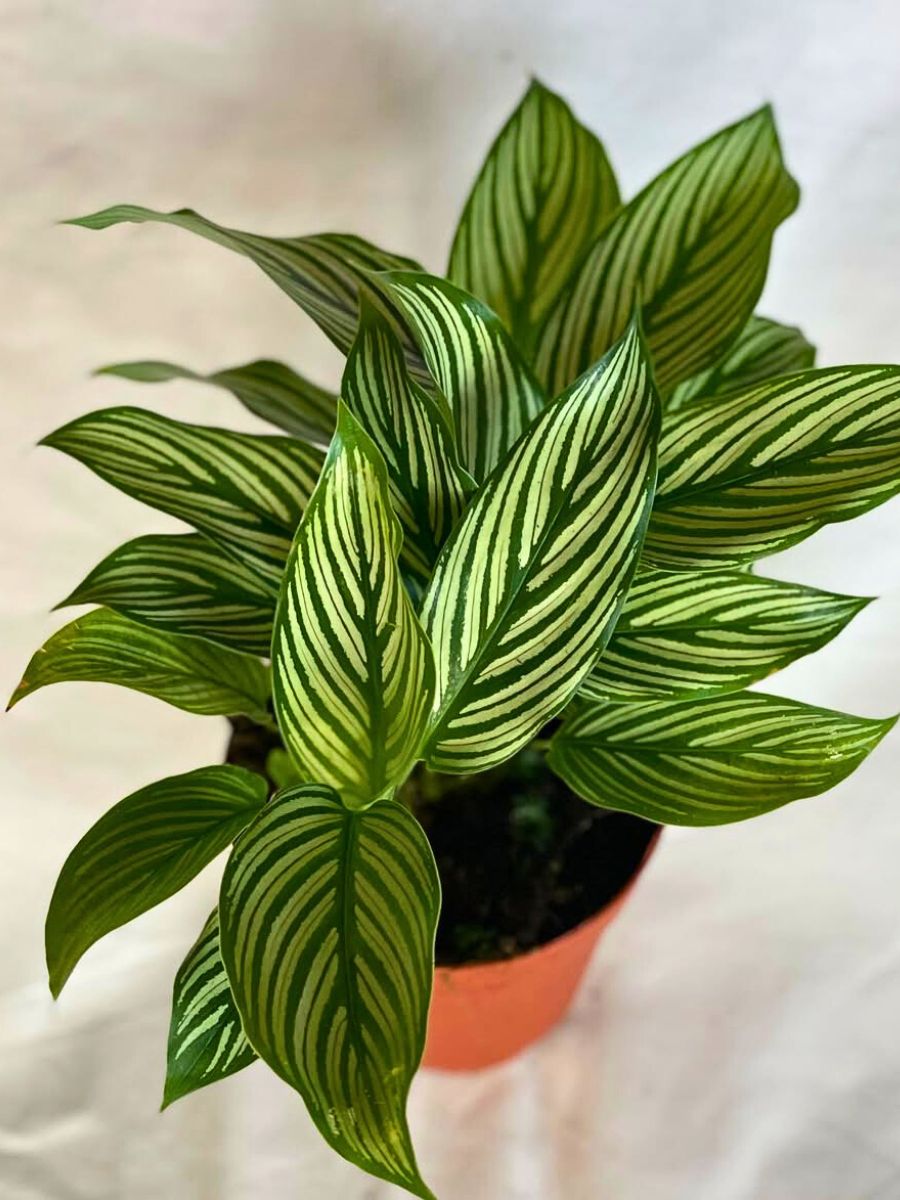
Fertilization practices for optimal Calathea vittata cultivation involve gentle, consistent nutrient provision rather than sporadic heavy feedings. Target to apply a balanced, water-soluble fertilizer at half-strength monthly during the growing season (spring through fall), suspending fertilization entirely during winter months when the plant's growth naturally slows.
Calathea Vittata Propagation Methods
For enthusiasts and prospective plant parents charmed by the Calathea vittata's distinctive beauty, propagation offers the opportunity to expand their collection or share these vegetal marvels with fellow plant admirers. Quite unlike many houseplants that readily propagate from stem cuttings, Calathea vittata propagation requires division. This is a straightforward yet precise process that yields multiple established plants when executed properly.
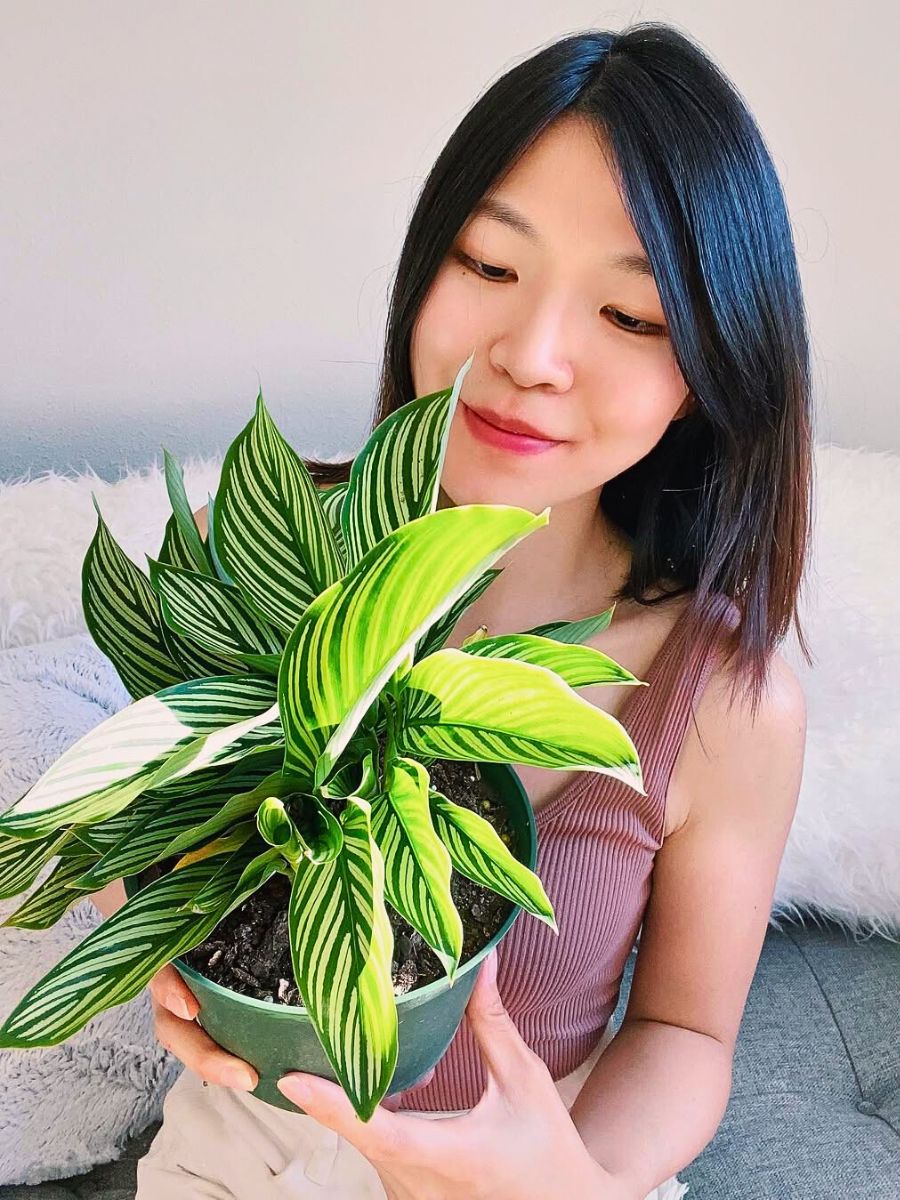
The ideal time for Calathea vittata propagation arrives during repotting in spring, when the plant emerges from winter dormancy with renewed vigor. Begin by carefully removing the entire plant from its container, gently loosening the root ball to expose the rhizomatous structure beneath the soil surface. Then, using clean, sharp scissors or a knife, separate natural divisions where multiple crowns have formed, ensuring each division retains both healthy foliage and an adequate portion of the root system.
Prepare fresh potting medium identical to that used for mature specimens, and plant each division at the same depth it previously grew, firming the soil gently around the roots. Water thoroughly to settle the soil and eliminate air pockets that can dry out delicate root hairs. Then, create a temporarily elevated humidity environment around newly divided plants using plastic bags or humidity domes. These will help the plants recover from the stress of division while establishing new root growth.
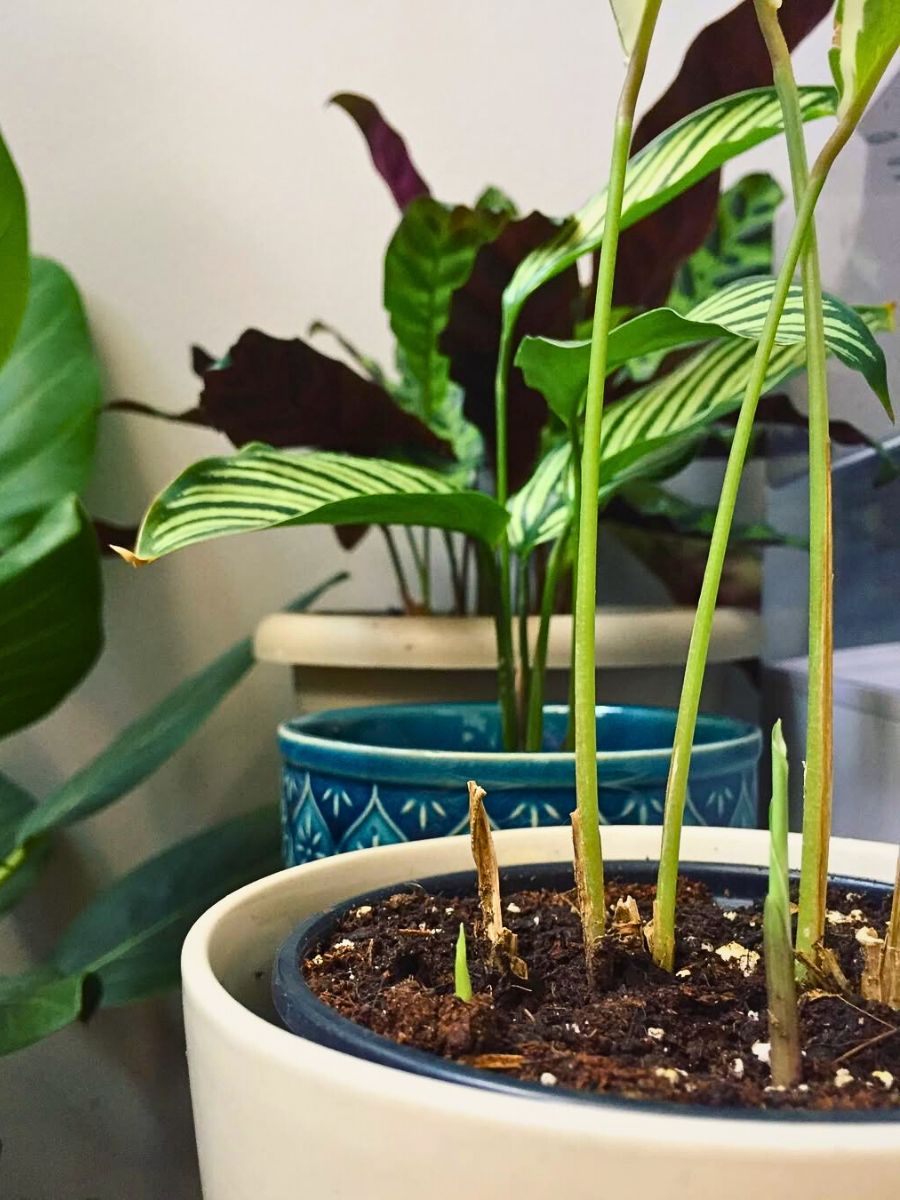
Patience plays a crucial role in successful Calathea vittata propagation, as divided specimens typically experience a recovery period before resuming active growth. During this establishment phase, maintain slightly higher humidity levels and consistent soil moisture, but avoid fertilization until new growth emerges.
Essential Calathea Vittata Care Guide
The key to effective Calathea vittata care requires understanding its rainforest origins and replicating those conditions within homes. This marvelous plant thrives when provided with the perfect balance of light, water, humidity, and temperature; a horticultural quartet of requirements that, when harmonized, rewards the diligent plant parent with spectacular foliage displays.
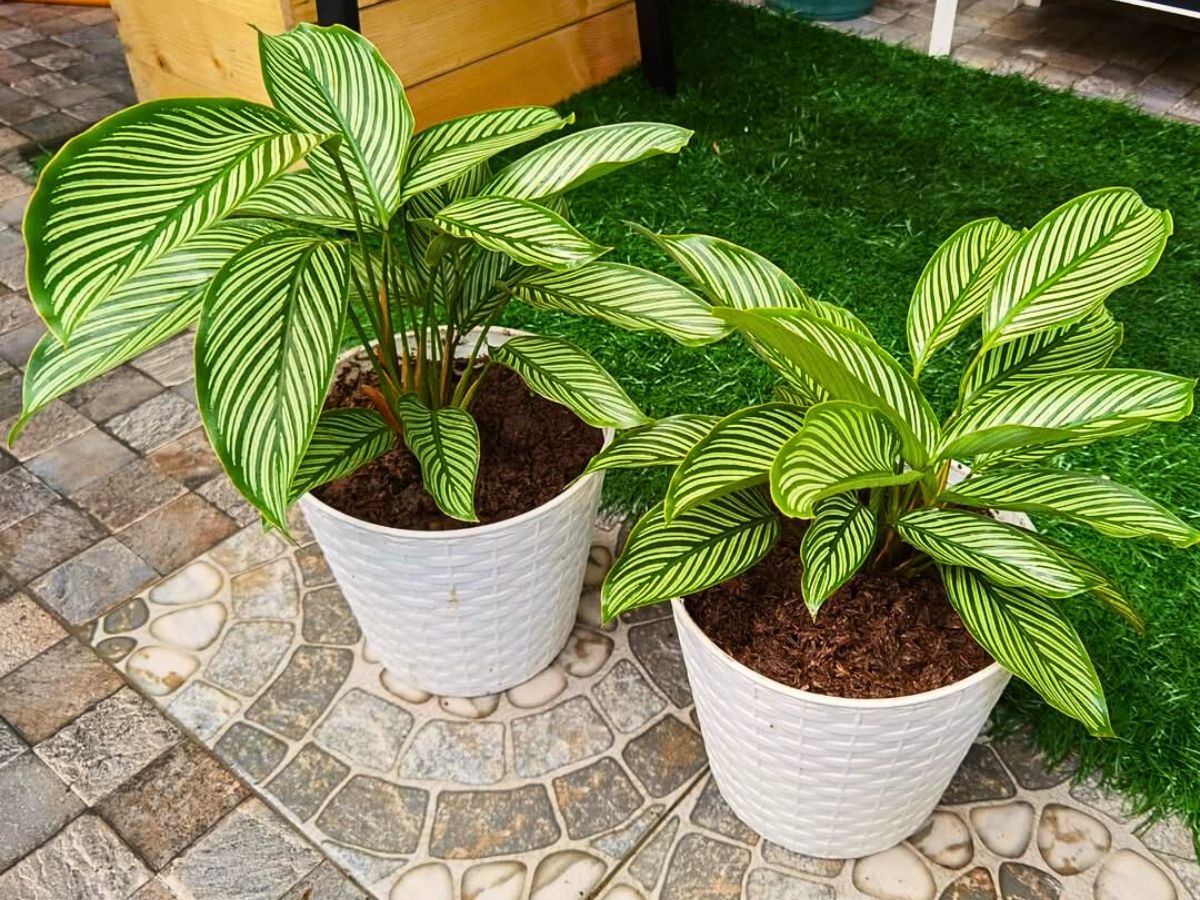
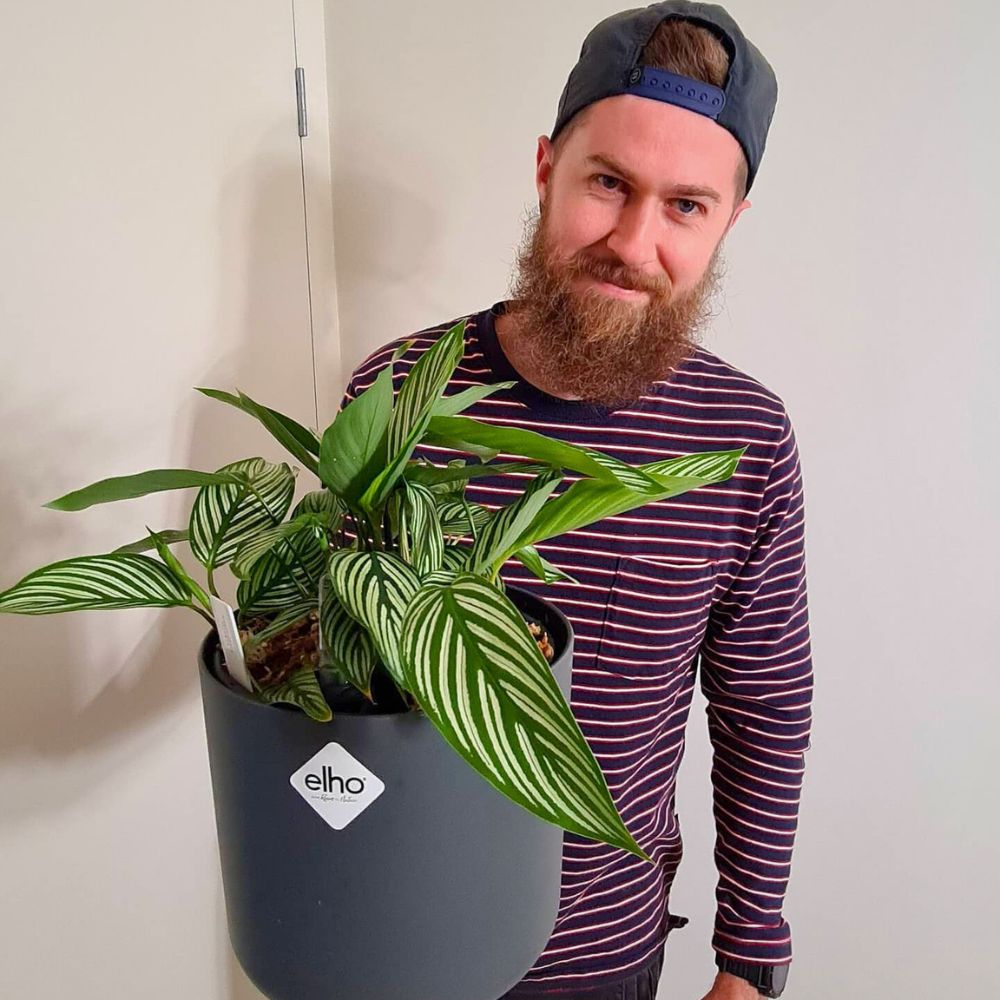
The light requirements for Calathea vittata reflect its understory habitat: bright, indirect sunlight that imitates the filtered light of the rainforest. Direct sunlight scorches its delicate leaves, while insufficient light dulls its striking patterns. So, position the Calathea vittata near an east-facing window with sheer curtains, or place it several feet away from south or west-facing windows to create the ideal light balance. One should also aim for 10-12 hours of gentle, diffused light daily to maintain the vibrant striping pattern that makes this plant so coveted.
Watering demands particular attention in Calathea vittata care. These moisture-loving plants prefer consistently damp, but never soggy, soil, echoing the humid forest floor of their native habitat. Establish a watering rhythm of once every 1-2 weeks, adjusting based on seasonal changes and indoor conditions. The cardinal rule is to never allow the soil to dry completely, but equally important, avoid waterlogged conditions that invite root rot.
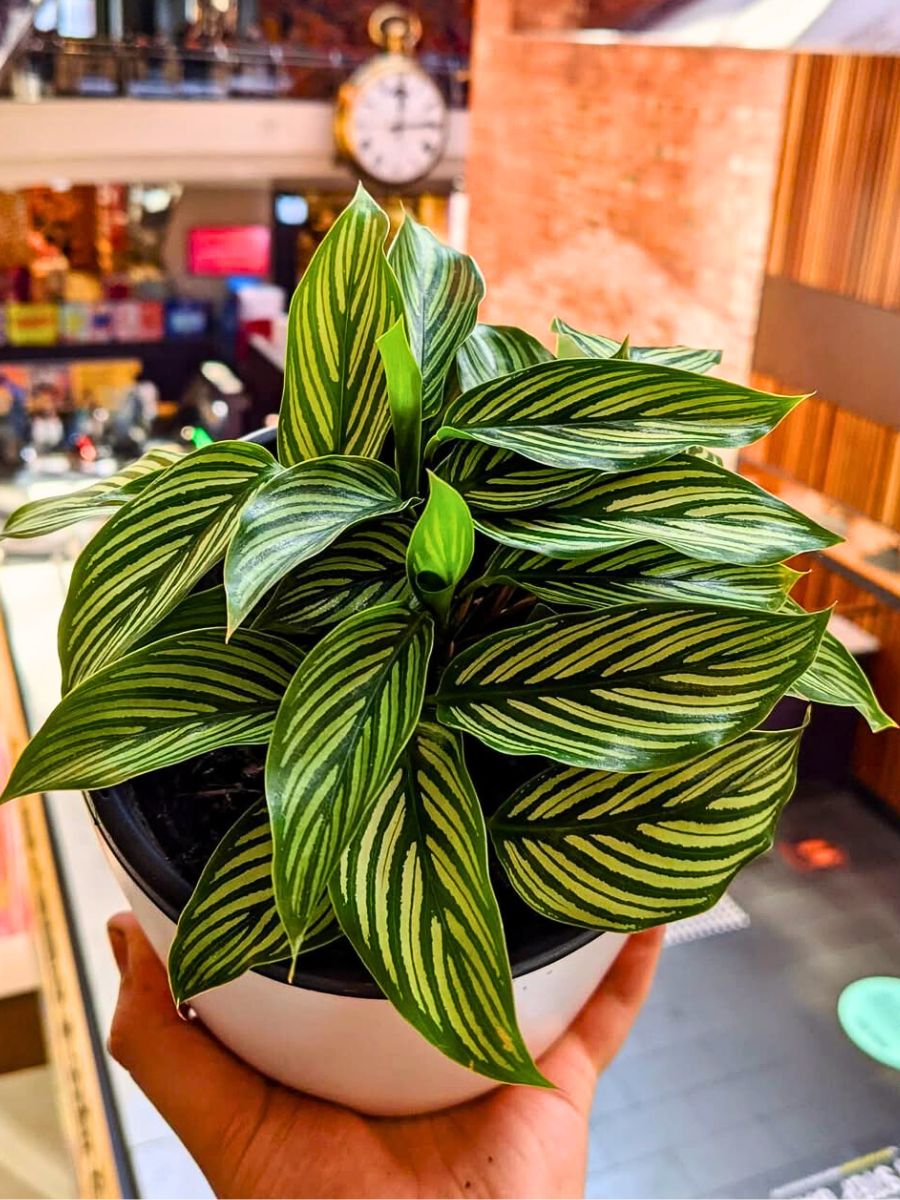
Temperature stability forms another crucial pillar of successful Calathea vittata care. One should maintain ambient temperatures above 15°C and vigilantly protect the plant from drafts, sudden temperature fluctuations, and air conditioning vents that can shock its sensitive system.
A Troubleshooting Guide to Solving Issues Like the Mystery of Calathea Vittata Brown Tips
The appearance of Calathea vittata's brown tips represents perhaps the most common lament among caretakers of these good-looking plants. These crispy, discolored edges act as the plant's visual distress signal, communicating that something in its environment requires adjustment. Often, low humidity is the primary culprit behind Calathea vittata's brown tips.
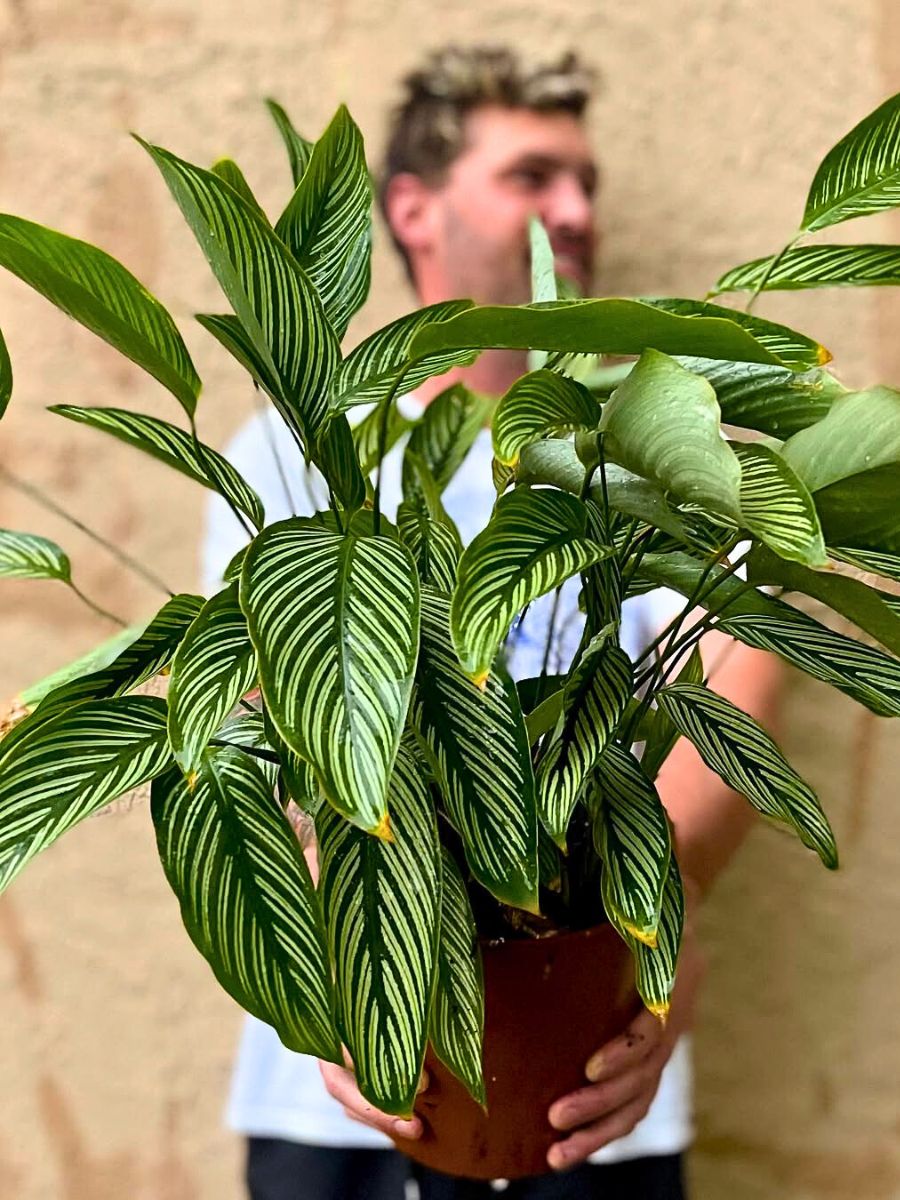
These tropical natives crave atmospheric moisture levels between 60%-70 %, significantly higher than the average household environment. When the surrounding air lacks sufficient moisture, the plant's leaf edges begin to desiccate, turning brown and crispy as a protective response. To address this, create a more hospitable microclimate by deploying a humidifier near the houseplant, arranging humidity trays filled with water and pebbles beneath the pot, or grouping multiple humidity-loving plants to create a self-sustaining moisture community.
Improper watering practices frequently contribute to Calathea vittata's brown tips as well. Both under-watering and overwatering can manifest in identical symptoms, creating a diagnostic challenge for plant enthusiasts. While under-watering deprives the plant of necessary moisture, causing leaf tissues to dry from the edges inward, overwatering it conversely, leads to root stress that impairs the plant's ability to transport water effectively, paradoxically resulting in drought-like symptoms despite soggy soil.
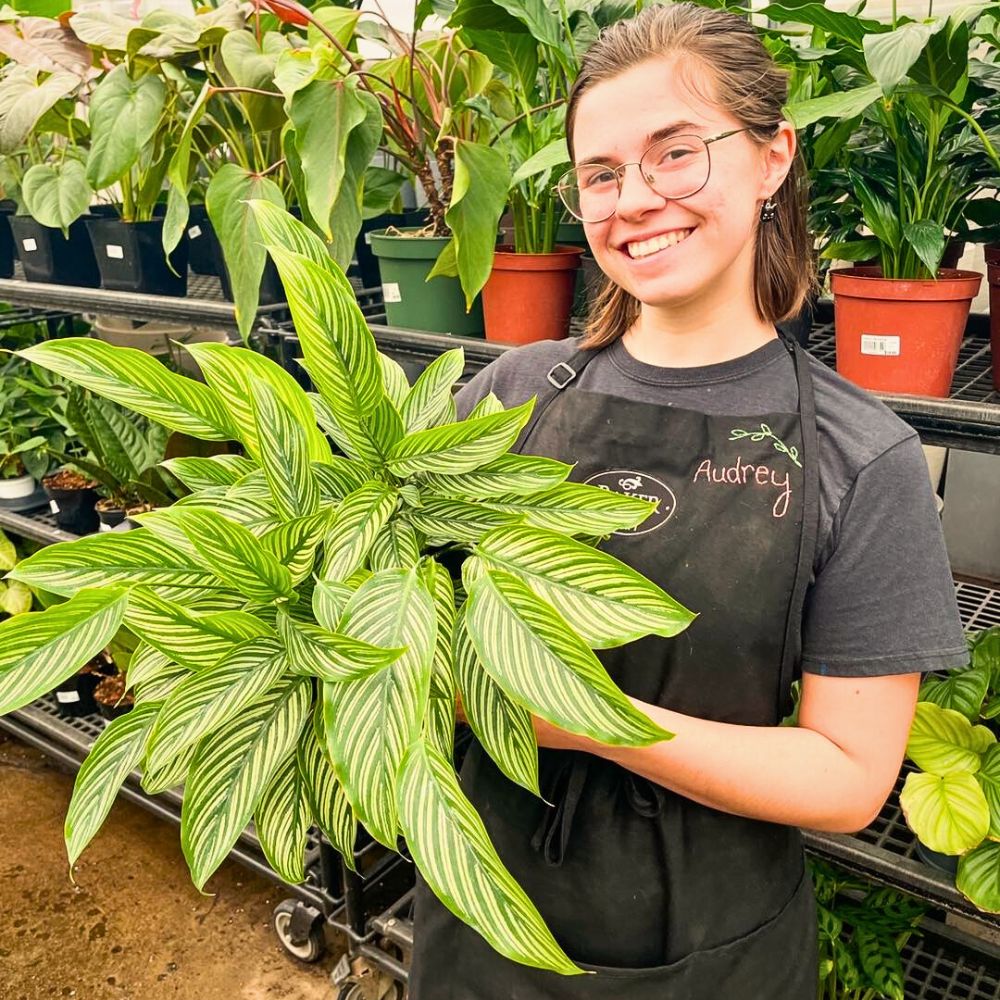
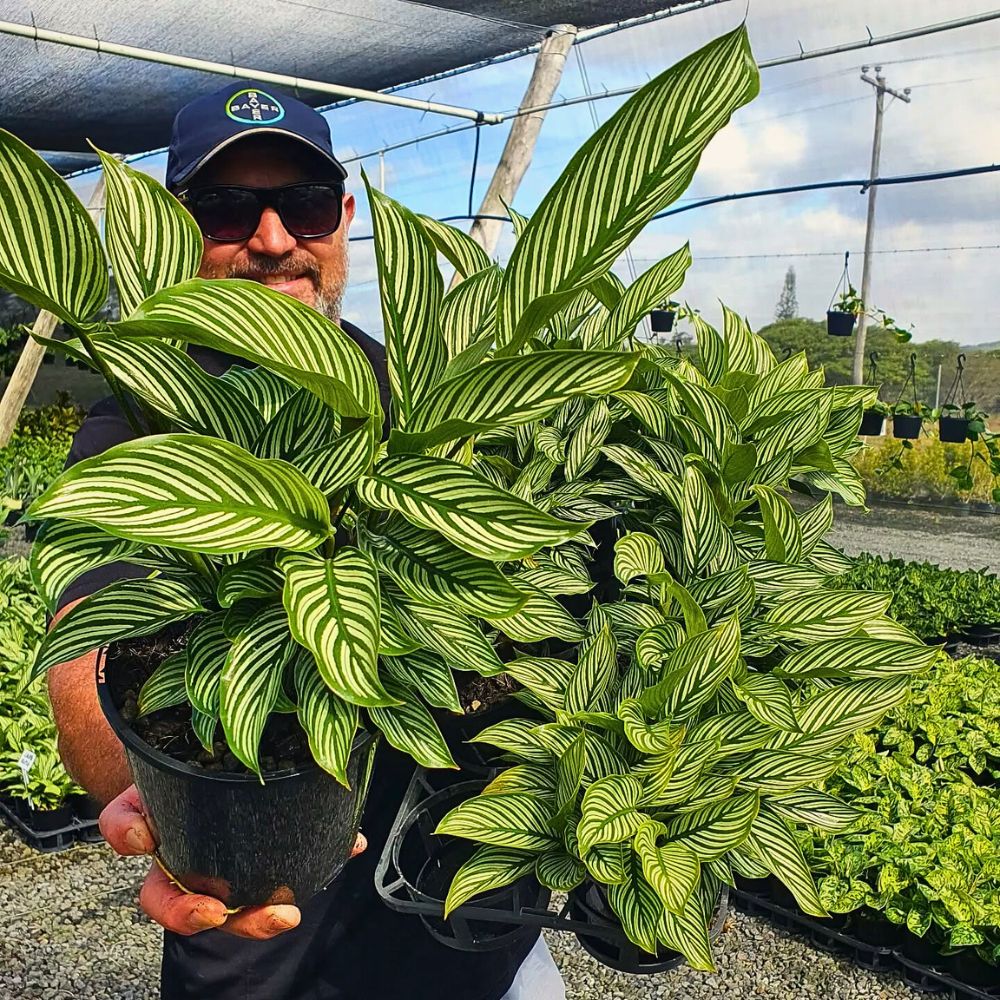
Also, the water quality deserves consideration when addressing Calathea vittata brown tips. These sensitive plants react poorly to fluoride, chlorine, and mineral salts commonly found in tap water. The buildup of these elements in soil can damage root systems and manifest as leaf discoloration.
Also, Why Do Calathea Vittata Plants’ Leaves Curl Sometimes?
When the Calathea vittata leaves’ curling happens, the plant is essentially speaking through its foliage, communicating specific environmental stressors that require attention. This distinctive response of the leaves rolling inward like scrolls signals conditions that contradict the plant's preferences and demands immediate intervention from an attentive caretaker.
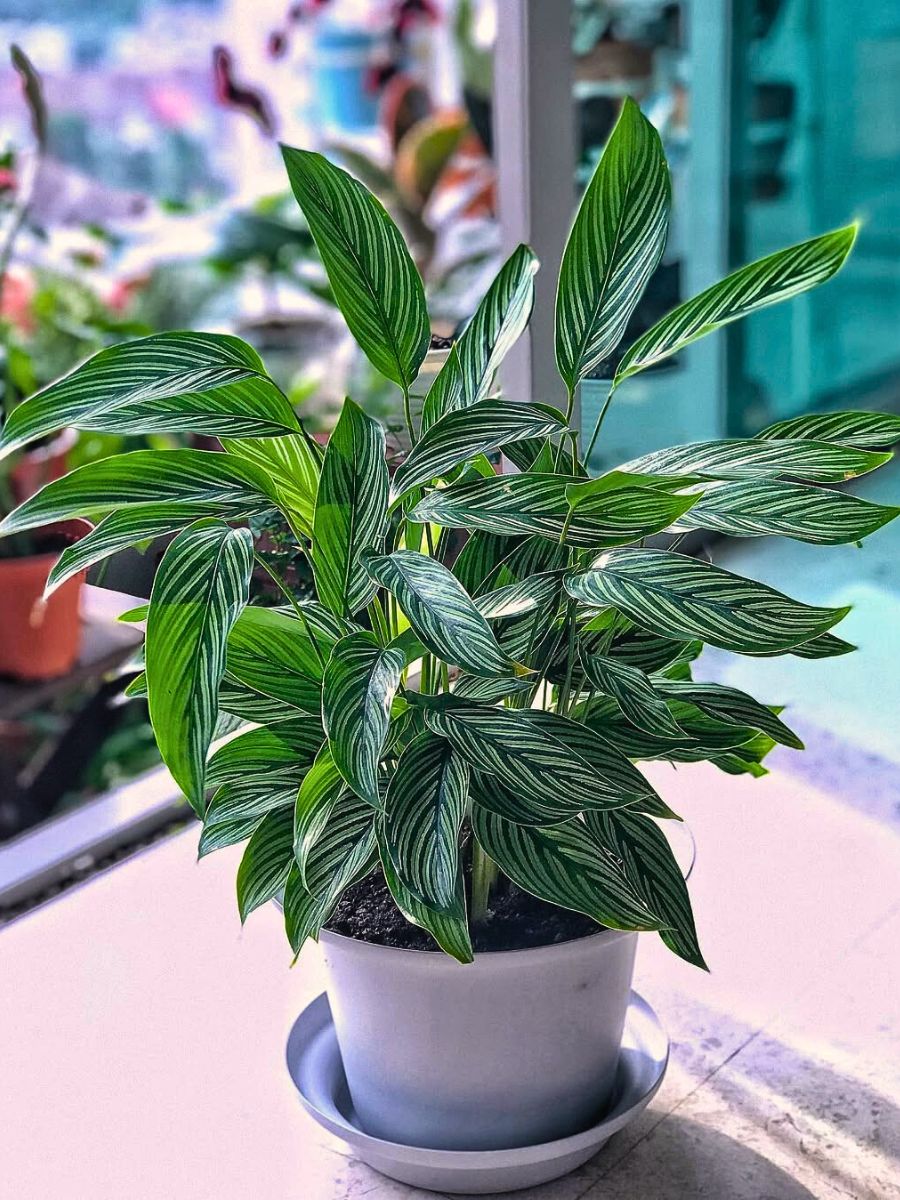
Insufficient humidity frequently triggers Calathea vittata leaves to curl as the plant attempts to reduce its surface area, thereby minimizing moisture loss through transpiration. This defensive maneuver, while clever from an evolutionary standpoint, diminishes the plant's ornamental value and indicates suboptimal growing conditions. Boosting atmospheric moisture through consistent misting, humidifier use, or pebble tray arrangements can resolve this common issue and restore the plant's natural leaf position.
Temperature extremes and drafts represent another common cause of Calathea vittata leaves curling. These tropical plants experience shock when subjected to cold air streams from windows, doors, or air conditioning vents, responding by curling their leaves protectively. Similarly, exposure to excessive heat from radiators or heating vents prompts the same defensive reaction.
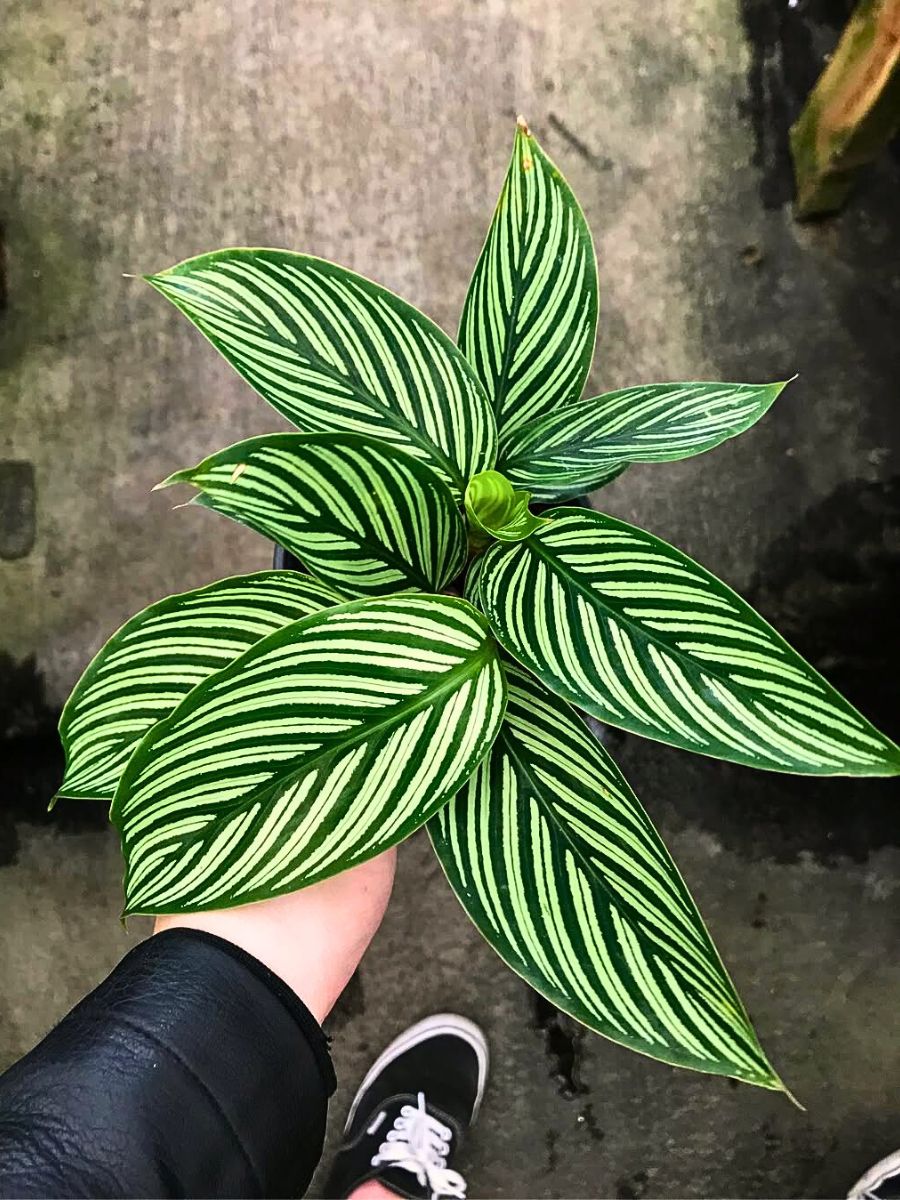
Pest infestations, particularly spider mites that thrive in dry conditions, can also cause Calathea vittata leaves to curl as these microscopic arachnids draw sap from leaf tissues. One can address these infestations promptly with insecticidal soap applications or neem oil treatments, repeating weekly until the problem resolves completely.
Advanced Calathea Vittata Care Tips and Fine Details
For those who have grasped the fundamentals of Calathea vittata care and seek to enhance their cultivation practices further, attention to subtle environmental factors and seasonal adjustments can transform good specimens into extraordinary ones. These refined techniques distinguish casual plant keepers from true Calathea connoisseurs.

Seasonal light adaptations, for instance, prove critical in maximizing Calathea vittata's distinctive patterning. During winter months when daylight diminishes, supplement natural light with grow lights specifically designed for foliage plants, positioning them 12-24 inches above the plant canopy. Choose full-spectrum LED options that provide the balanced light wavelengths necessary for photosynthesis without generating excessive heat that could damage sensitive tissues.
Likewise, leaf cleaning rituals not only enhance Calathea vittata's appearance but also optimize its physiological functions. Dust accumulation on leaf surfaces blocks precious light and clogs the stomata through which plants breathe and transpire. Establish a periodic routine of gently wiping each leaf with a soft, damp cloth to remove particulate matter, taking care not to tear or damage the delicate foliage.
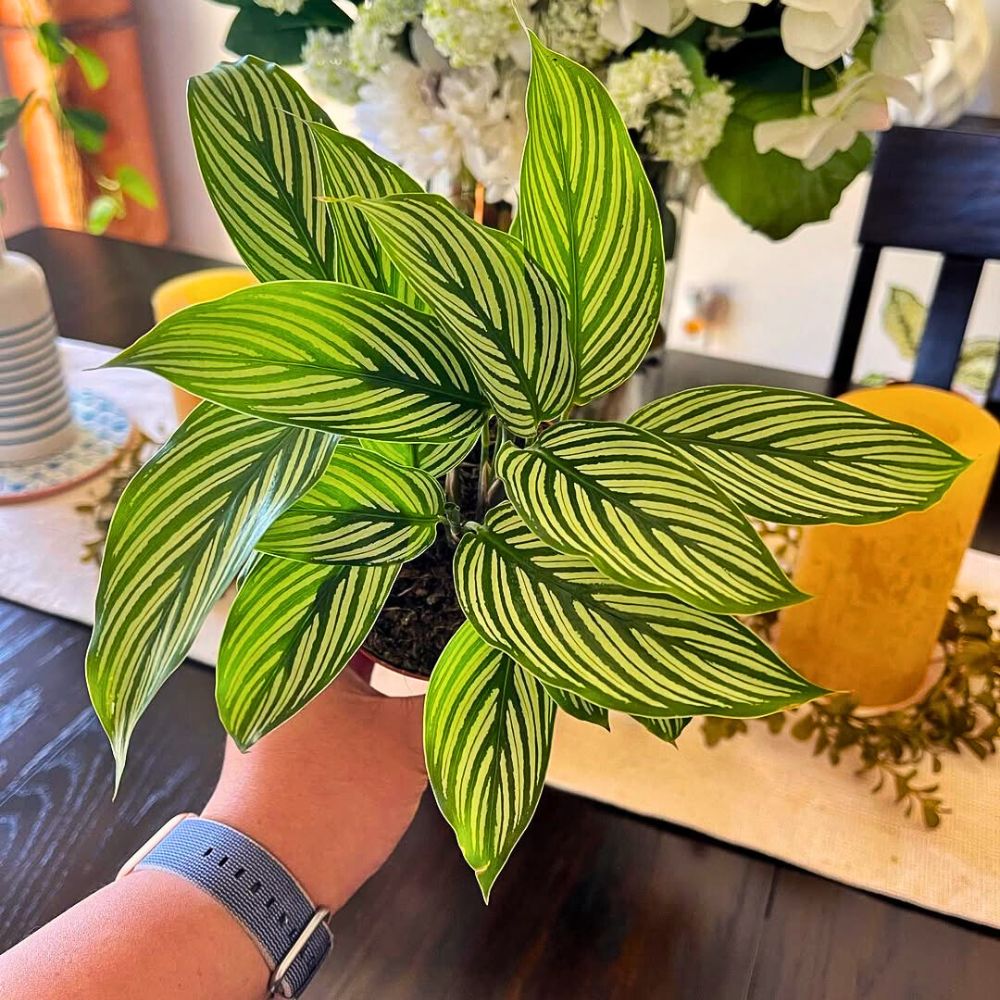
Rotation schedules also prevent uneven growth as Calathea vittata naturally bends toward light sources. Implement a quarter-turn rotation weekly to ensure all sides receive equal light exposure, resulting in symmetrical growth patterns that maintain the plant's naturally balanced form. Basically, as an expert or a budding plant parent, the journey of cultivating and caring for a Calathea vittata may present occasional challenges in the form of brown tips or curling leaves, yet these moments of communication between plant and caregiver offer opportunities for deeper understanding and more refined cultivation practices.
Decorating With the Calathea Vittata
The Calathea vittata's architectural form and striking foliage patterns make it an exceptional decorative element for interior spaces ranging from minimalist modern to lush bohemian. This versatile plant serves not merely as greenery but as a kind of living figurine that enhances design aesthetics while concurrently purifying air and adding textural dimension to composed spaces.
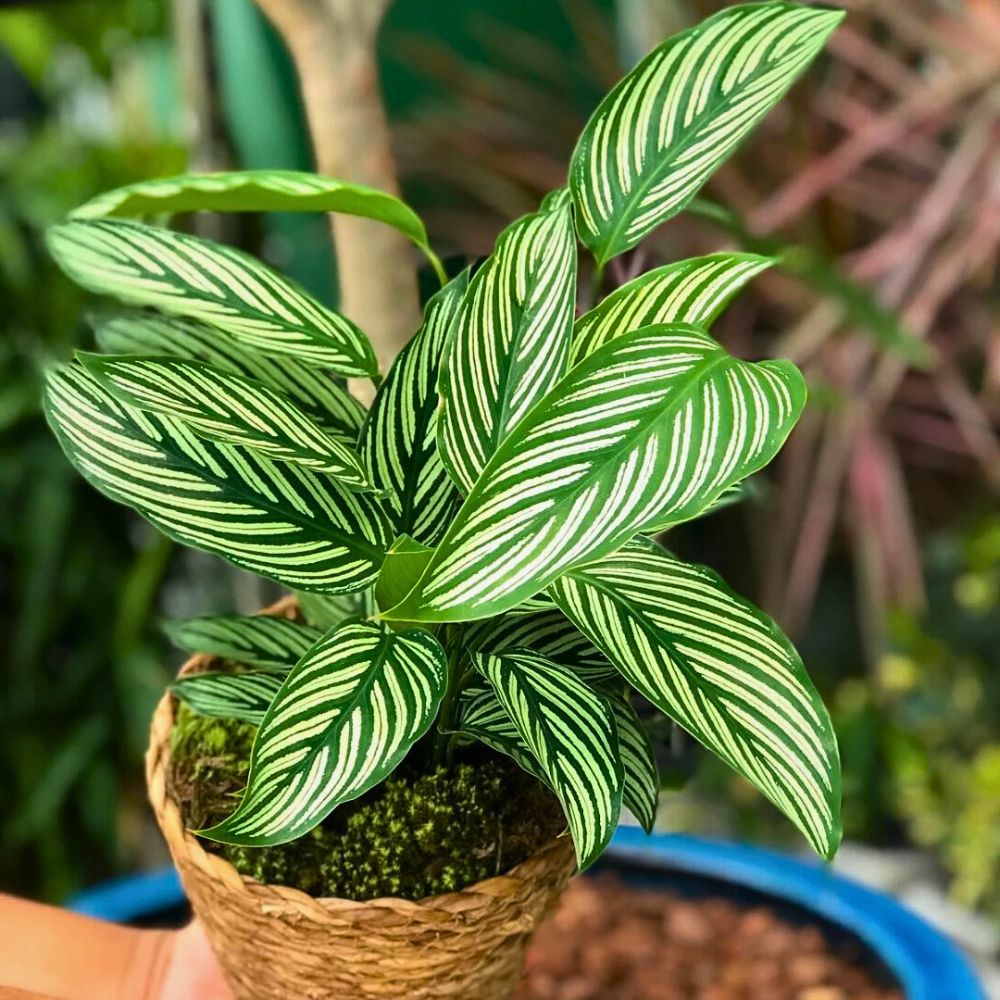
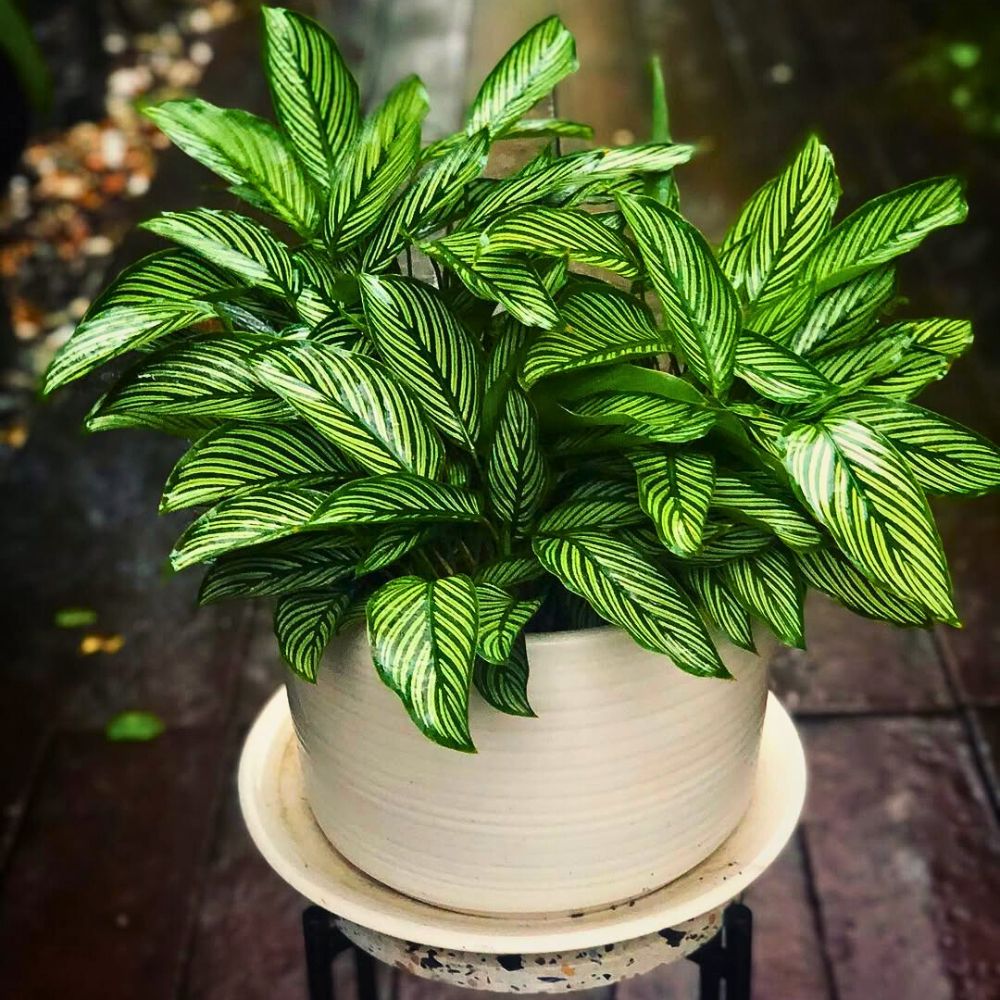
In contemporary interiors, one can position the Calathea vittata as a statement piece against neutral backgrounds that showcase its dramatic striping pattern. The plant's striking coloration harmonizes particularly well with monochromatic décor schemes, adding organic pattern without competing with other design elements. Enhance its presence using architectural planters in materials like matte ceramic, brushed metal, or textured concrete that complement the plant's refined appearance.
Also, create botanical vignettes by grouping Calathea vittata with complementary tropical specimens like Monstera, Alocasia, and other Calathea varieties, arranging them at varying heights to mimic natural forest stratification. This approach transforms ordinary corners into immersive plant experiences that seem to take one to exotic destinations through living décor.
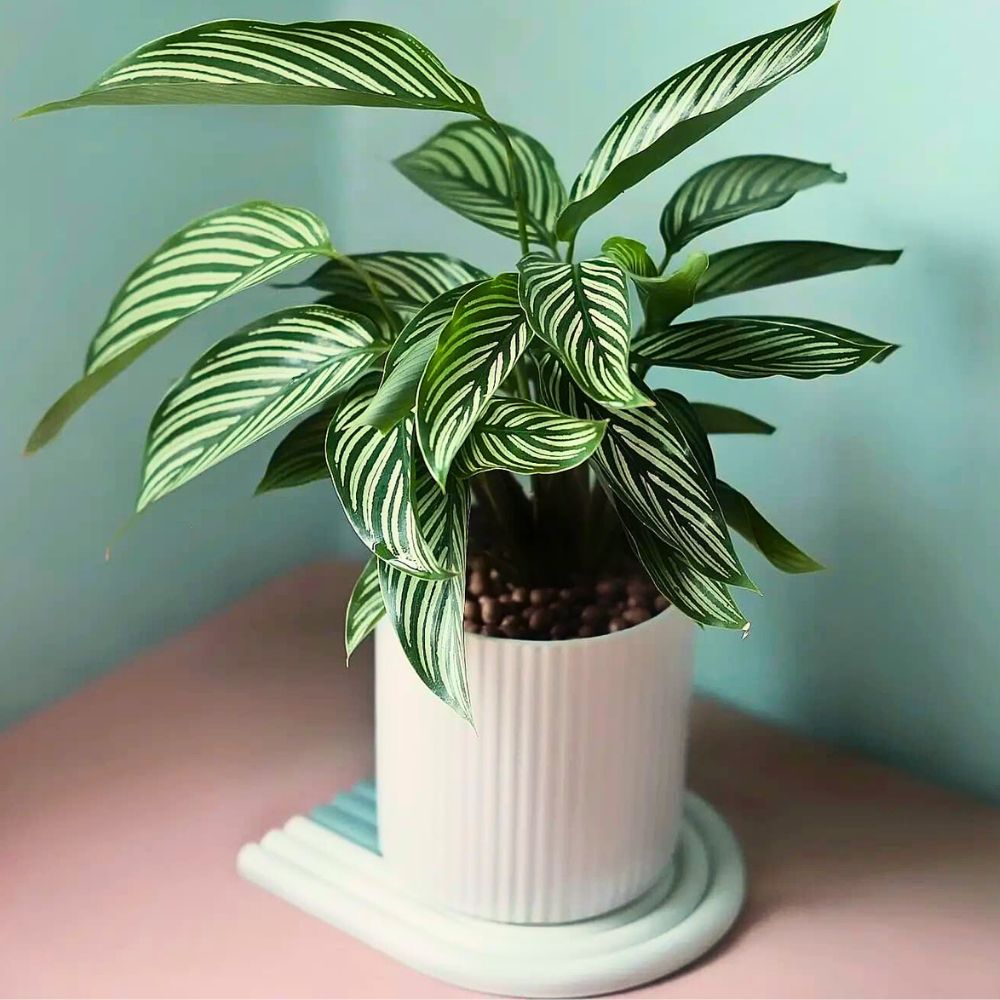
Aside from traditional potted displays, also consider incorporating Calathea vittata into bathroom environments where naturally elevated humidity levels support optimal growth while the plant's tropical aesthetic enhances spa-like atmospheres. Plus, bathrooms' consistent moisture and filtered light often provide ideal growing conditions without supplemental humidification, guaranteeing that you fully enjoy the tropical charm that this houseplant exudes.
Feature image by @russgoswholesale, header image by @chlorophylledhome

